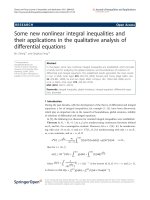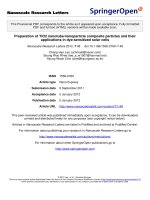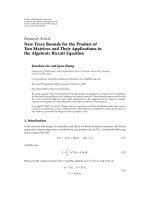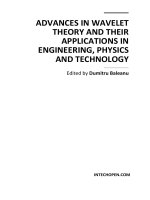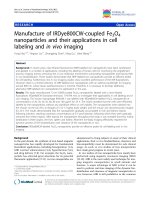Probit based stochastic user equilibrium problems and their applications in congestion pricing
Bạn đang xem bản rút gọn của tài liệu. Xem và tải ngay bản đầy đủ của tài liệu tại đây (1.56 MB, 249 trang )
PROBIT-BASED STOCHASTIC USER EQUILIBRIUM
PROBLEMS AND THEIR APPLICATIONS IN
CONGESTION PRICING
LIU ZHIYUAN
NATIONAL UNIVERISTY OF SINGAPORE
2011
PROBIT-BASED STOCHASTIC USER EQUILIBRIUM
PROBLEMS AND THEIR APPLICATIONS IN
CONGESTION PRICING
LIU ZHIYUAN
(B.ENG., Southeast University, Nanjing, China)
A DISSERTATION SUBMITTED
FOR THE DEGREE OF DOCTOR OF PHYLOSOPY
IN THE DEPARTMENT OF
CIVIL AND ENVIRONMENTAL ENGINEERING
NATIONAL UNIVERISTY OF SINGAPORE
2011
I
ACKNOWLEDGEMENT
My sincerest appreciation goes to my supervisor, Associated Professor Meng Qiang for
his guidance, constructive suggestions and continuous encouragement throughout my
graduate education. In each stage of my Ph.D study, from course study to the qualifying
exams and to the research work, he was always supportive and giving me valuable
advices. Without him, the work in this dissertation would not be possible. He will always
be taken as a mentor and friend throughout my career and life.
I am very grateful to Prof. Chin Hoong Chor, Dr. Ong Ghim Ping Raymond and Dr.
Szeto Wai Yuen for their encouragement and advices on this research work.
I also acknowledge Mr. Foo Chee Kiong, Madam Yap-Chong Wei Leng, and Madam
Theresa Yu-Ng Chin Hoe for their hospitality and kind assistance.
Thanks are also extended to my research colleagues: Qu Xiaobo, Khoo Hooi Ling, Wang
Tingsong, Wang Xinchang, Wang Shuaian, Weng Jinxian, H.R. Pasindu, William Yap,
Zhang Jian, Zhao Ben, Xu Haihua, and Yan Yadan for their support and cooperation
throughout my Ph.D study. A special debt of gratitude is also owed to the other research
mates for their help and encouragement.
Finally, my deepest appreciation goes to my parents, my parents-in-law and my beloved
wife Wang Zhijing for their endless love as well as enthusiastic and consistent support for
my Ph.D study.
III
TABLE OF CONTENTS
ACKNOWLEDGEMENT I
TABLE OF CONTENTS III
ABSTRACT VII
GLOSSARY OF NOTATION XI
ACRONYMS XIV
CHAPTER 1 INTRODUCTION 1
1.1 Background and Motivations 1
1.2 Research Scope 5
1.3 Objectives 6
1.4 Organization of the Dissertation 7
CHAPTER 2 LITERATURE REVIEW 11
2.1 Users’ Travel Behavior and Probit-based SUE 11
2.1.1 User’s travel behavior and SUE 11
2.1.2 Models and Algorithms for the SUE Problem 15
2.1.3 Stochastic Network Loading Procedure 17
2.1.4 Parallel Computing for Monte Carlo simulation 19
2.2 Extensions of Conventional User Equilibrium Problem 21
2.2.1 Elastic Demand 21
2.2.2 Asymmetric Link Travel Time Functions 25
2.2.3 Link Capacity Constraints 27
2.3 Congestion Pricing with User Equilibrium Constraints 30
2.3.1 First-Best and Second-Best Congestion Pricing 31
2.3.2 Cordon-based Congestion Pricing Schemes 33
2.3.3 Continuously Distributed Value-of-Time 36
CHAPTER 3 TWO EFFICIENT PREDICTION-CORRECTION ALGORITHMS
FOR PA-SUEED 39
3.1 Background 39
3.2 SUE Conditions and Two Fixed-point Models 41
IV
3.2.1 Notation and Definitions 41
3.2.2 Probit-based Asymmetric SUE Conditions with Elastic Demand 44
3.2.4 A Stochastic Network Loading Map and Two Fixed-Point Formulations 44
3.3 Two Variational Inequality Models 46
3.4 Link-based Two-stage Monte Carlo Simulation for SNL 51
3.4.1 An Alternative Representation of Perception Error 52
3.4.1 Two-stage Monte Caro Simulation-based SNL Method 53
3.4.2 Sample Size Estimation 56
3.5 Three Solution Algorithms 60
3.5.1 Two Projection-type Self-adaptive Prediction-Contraction Algorithms 60
3.5.2 Cost-Averaging Algorithm 66
3.5.3 Two Hybrid Prediction-Correction Algorithms 66
3.6 Numerical experiments 68
3.6.1 Example 1 70
3.6.2 Example 2 79
3.7 Conclusions 82
CHAPTER 4 PA-SUEED WITH LINK CAPACITY CONSTRAINTS 85
4.1 Background 85
4.2 Generalized SUE Conditions 86
4.3 Mathematical Model 90
4.3.1 Monotone and Continuous Properties of the Vector Function 92
4.3.2 A Restricted Variational Inequality Model 98
4.4 Solution Algorithm 106
4.5 Numerical Experiment 109
4.6 Conclusions 112
CHAPTER 5 DISTRIBUTED COMPUTING APPROACHES FOR SOLVING PA-
SUEED 115
5.1 Background 115
5.2 Three Distributed Computing Approaches 117
5.2.1 Distributed Loading Approach 117
5.2.2 Distributed Shortest-Path Approach 118
5.2.3 Integrated Loading Approach 120
5.3 Computing Platform and Performance Measures 123
5.3.1 Computing Platform 123
5.3.2 Three Performance Measures 124
V
5.4 Numerical Examples 126
5.4.1 Sioux-Falls Network 128
5.4.2 Random Graph Example 135
5.4.3 Anaheim Network 137
5.5 Conclusions 138
CHAPTER 6 SPEED-BASED TOLL DESIGN FOR CORDON-BASED
CONGESTION PRICING SCHEME 141
6.1 Background and Relevant Studies 142
6.2 Problem Statement and MPEC Model for Speed-Based Toll Design 145
6.2.1 Notation and Definitions 145
6.2.2 MPEC Model for the Speed-Based Toll Design Problem 149
6.2.3 PA-SUEED Problem with Continuously Distributed VOT 151
6.3 Solution Algorithm for the Speed-based Toll Design 152
6.3.1 Revised Genetic Algorithm 153
6.3.2 Decomposition of Revised Genetic Algorithm for Distributed Computing
155
6.4 Numerical Example 157
6.4.1 Simulation Method for the Average Travel Speed in Each Cordon 162
6.4.2 Computational Results of Distributed Revised Genetic Algorithm 163
6.5 Conclusions 167
CHAPTER 7 DISTANCE-BASED TOLL DESIGN FOR CORDON-BASED
CONGESTION PRICING SCHEME 169
7.1 Background and Relevant Studies 169
7.2 Toll-Charge Function and Optimal Distance-based Toll Design 173
7.3 PA-SUEED Problem with Non-additive Distance-based Charge 176
7.3.1 Network Transformation for Non-additive Path Toll Charges 177
7.3.2 A Monte Carlo Simulation Method on the Composite Network 179
7.4 Two MPEC Models for the Optimal Distance-Based Toll Design 182
7.4.1 Total Social Benefit and the Exact MPEC Model 182
7.4.2 A Mixed-integer MPEC Model with a Piecewise-linear Approximation
Function 184
7.5 Solution Algorithm 186
7.6 Numerical Experiment 189
7.6.1 KM Charge 191
7.6.2 Nonlinear Distance-based Charge 193
7.7 Conclusions 197
VI
CHAPTER 8 CONCLUSIONS 199
8.1 Outcomes and Research Contributions 199
8.2 Recommendations for Future Work 202
REFERENCES 205
LIST OF PUBLICATIONS 229
VII
ABSTRACT
When compared to other user equilibrium principles for traffic assignment, the probit-
based stochastic user equilibrium (SUE) is known to have properties well suited for
practical conditions. However, theoretical studies and practical implementations of
probit-based SUE are largely limited due to the difficulties of solving such a problem.
Thus, a primary objective of this dissertation is to inherently reduce the computational
time of solving the probit-based SUE problem. To further improve its suitability to
practical conditions, the following extensions are further taken into consideration for the
traffic assignment problem (a) elastic demand, (b) asymmetric link travel time functions,
termed as probit-based asymmetric SUE problem with elastic demand (PA-SUEED).
Although it converges sub-linearly, the cost averaging (CA) method is the only known
convergent algorithm for PA-SUEED in the literature. This dissertation accelerates the
computation of PA-SUEED from two aspects: firstly, it proposes two projection-type
prediction-correction (PC) algorithms with linear convergent speed. As validated by
numerical experiments, the two PC algorithms can accelerate the computational speed for
five to ten times, when compared with CA method; secondly, note that the solution
algorithms for SUE problems need to calculate the stochastic network loading (SNL)
problem in each iteration, and solution algorithm for the SNL in the context of PA-
SUEED is still an open question. A link-based two-stage Monte Carlo simulation method
is proposed for the SNL problem, wherein each trial of this Monte Carlo simulation
method is independent with identical tasks, thus it has a superior parallelism. Therefore,
this dissertation further improves the computational speed of solving PA-SUEED by
VIII
proposing three distributed (parallel) computing approaches for its SNL problem. Based
on a comprehensive numerical experiment, it shows that the distributed computing
approaches can further improve the computational speed for over fifty times.
Link capacity constraints are recognized to be a logical extension of standard traffic
assignment problems. However, studies for SUE problem with link capacity constraints
are fairly scarce, due to the difficulties in formulating and solving this problem. In the
context of PA-SUEED, this problem becomes even more complicated and challenging.
This dissertation thus investigates about formulating and solving the PA-SUEED with
link capacity constraints, which is a highly mathematical topic with considerable
theoretical contributions. A VI model is proposed and the monotonicity and Lipschitz-
continuity of this VI model are rigorously proven. Based on these properties of the VI
model, convergence of a PC algorithm thus can be guaranteed to solve the VI model. The
proposed methodology is finally validated by a numerical example.
The un-cooperative travel behavior of drivers would usually lead to traffic congestions,
especially in the dense urban areas. Thereby, the network authorities intend to encourage
them to use uncongested road segments. Congesting pricing is one of the few instruments
for this purpose, thus it is a good complement for the studies of traffic assignment. Note
that the drivers’ value-of-time (VOT) is necessitated for the analysis of congestion
pricing. In this study, VOT is assumed to be continuously distributed, to cover the vast
diversity of drivers’ income levels. On the other hand, the drivers’ diversity of perception
errors on travel times should also be considered, which gives rise to SUE principles. Thus,
another objective of this dissertation is to investigate about the congestion pricing
IX
problem with PA-SUEED constraints. Originated from the current toll adjustment
procedure used by the Electronic Road Pricing (ERP) system in Singapore, a practical-
oriented research topic, termed as speed-based toll design, for cordon-based congestion
pricing scheme is discussed. Subsequently, in view that the ERP system intends to update
its current entry-based charge to a distance-based charge, the distance-based toll design
for cordon-based congestion pricing scheme is then formulated and solved. These two
toll design topics are of considerable importance to the practical implementations of
congestion pricing schemes. It should be noted that formulations and solution algorithms
for congestion pricing problems with probit-based SUE constraints are also quite limited.
Thus, the achievements in this dissertation not only contribute to the theoretical studies of
congestion pricing problems, but also significantly facilitate to the practical operations
and supervisions of congestion pricing schemes.
XI
GLOSSARY OF NOTATION
A
Set of links
A
Cardinality of set
A
wk
c
Travel time on path
w
kR
,
w
wk a ak
aA
ct
vv
w
c
Column vector of travel time on all the paths associated with OD pair
wW ,
T
,
wwk w
ckRc
D
Demand function
w
f
Column vector of traffic flows on all the paths between OD pair
wW ,
namely,
T
,
wwk w
fkRf
f
Column vector of traffic flow on all the paths in the network, i.e.,
T
,
w
wWff
a
h
Capacity of link flow
a
v
a
H
A threshold for link flow
a
v
, i.e.,
aa
Hh
N
Set of nodes
wk
p
Choice probability of path
w
kR
w
q
Travel demand between OD pair
wW
q
Column vector of all the OD travel demands,
T
,
w
qwWq
w
q
Upper bound of
w
q
w
R
Set of all the paths between OD pair
wW
w
R
Cardinality of set
w
R
XII
w
S
Satisfaction function, the expected minimal cost on paths between
wW
a
t v
Travel time on link
aA
, and it is a function of link traffic flow vector
v
tv
Column vector of all the link travel time functions,
T
,
a
taAtv v
0
a
t
Free flow travel time of link
aA
a
v
Flow on link
aA
v
Column vector of all the link traffic flows,
T
,
a
va Av
u
Column vector of all the Lagragian multipliers of the capacity constraints
W
Set of OD pairs
Drivers’ value-of-time
i
average speed of all the vehicles in cordon
i
i
(
i
)
predetermined lower (upper) bound of
i
τ
Column vector of toll charges,
T
,
a
aA τ
w
Link/path incidence matrix associated with OD pair
wW , namely,
,,
w
wak w
aAkR
Link/path incidence matrix for the entire network,
,
w
wW
wk
Drivers’ perception error on
wk
c
w
ζ
Column vector of perception errors on all the paths between OD pair
wW , i.e.,
T
,
wwk
wW ζ
OD pair/path incidence matrix,
,,
wk w
wWk R , where
wk
XIII
equals to 1 if path
w
kR
and 0, otherwise
Symbol for feasible sets, for instance,
v
is the feasible set for link flows
XIV
ACRONYMS
CA Cost-averaging method
CBD Central Business District
CDF Cumulative Distribution Function
DL Distributed Loading
DRGA Distributed Revised Genetic Algorithm
DSP Distributed Shortest-Path
DUE Deterministic User Equilibrium
ERP Electronic Road Pricing system in Singapore
GA Genetic Algorithm
IIA Independent and irrelevant alternatives
IL Integrated Loading
LTA Land Transport Authority
MPEC Mathematical programming with equilibrium constraints
MSA Method of Successive Average
OD Origin-Destination
PA-SUEED Probit-based Asymmetric SUE problem with Elastic Demand
PC Prediction-correction algorithm
PDF Probability density function
SNL Stochastic network loading
SO System Optimum
SUE Stochastic User Equilibrium
TAP Traffic assignment problem
XV
TSB Total social benefit
UE User Equilibrium
VI Variational inequality
VOT Value-of-time
1
CHAPTER 1 INTRODUCTION
1.1 Background and Motivations
Transportation planning for urban road networks aims to effectively and efficiently
satisfy the citizens’ requirement for movement, which may influence economic vitality
and affect the quality of life (Shiftan et al., 2007). Together with an enormous increase in
demand, some other challenges have emerged for the transportation planning, which
include environmental degradation and global warming, safety issue and increasing
complexity of commuters’ travel behavior. To cope with these challenges, the studies for
transportation planning have attracted much attention.
The most well-known approach for urban transportation planning so far is the four-step
method, including trip generation, trip distribution, mode split, and traffic assignment
(Bell and Iida, 1977; Patriksson, 1994a; Ortuzar and Willumsen, 1995). Among these
four steps, traffic assignment was the first and most-prevalent topic investigated by the
professionals. Traffic assignment deals with allocating traffic demands to existing or
hypothetical transportation networks. It can hence be utilized to assess the deficiencies in
the existing network or the effects of some improvements (expansions of the road section
or some newly built links), and to evaluate alternative transportation system plans.
Furthermore, traffic assignment is also a preliminary for some research topics based on
the transportation network, e.g. congestion pricing problems (Ferrari, 1995; Yang and
Huang, 2005; Verhoef et al., 2008), signal control problems (Smith, 1987; Yang and
Yagar, 1995; Wong and Yang, 1997), network design problems (Abdulaal and LeBlanc,
1979; Ben-Ayed et al., 1988; Yang and Bell, 1998) and Origin-Destination (OD) matrix
Chapter 1 Introduction
2
estimation problems (Maher, 1983; Bell, 1991; Yang et al., 1992; Cascetta and Postorino,
2001).
The first approach used for traffic assignment is the all-or-nothing assignment; i.e. all the
travel demand is allocated to the shortest path. No iterative updates are required for this
approach and it is thus quite computationally economical. But this technique is unrealistic
and it gives rise to improper results as per some early empirical studies (e.g. Campbell,
1950; Carroll, 1959).
Most well designed transportation systems rely on good understanding of human
behaviors. A milestone of the studies in traffic assignment also results from an in-depth
analysis of the commuters’ travel behaviors. Wardrop (1952) proposed two famous
principles for the network flows: (a) the User Equilibrium (UE), when assuming that all
the network users make their route choice by selecting the path with minimal travel time.
This assumption would give rise to equilibrium of network flows, where no one can
reduce his/her trip time by changing the trip route; (b) the System Optimum (SO), by
assuming that the users would mutually cooperate to minimize the total travel time in the
transportation system. In reality, the UE principle is more realistic, since the users are
non-cooperative when making trip decisions.
These two principles are vital foundations for the mathematical models and algorithms
developed for the traffic assignment problems. A major breakthrough was put forward by
Beckmann et al. (1956) via a convex nonlinear optimization model, whose solution is the
Chapter 1 Introduction
3
UE link flow. Note that Frank and Wolfe (1956) provided a convex combination
algorithm for solving the nonlinear convex optimization problems, which is a method of
feasible directions. When applying this method to solve Beckmann et al.’s model, it
incorporates a series of sub-problems which are merely the all-or-nothing assignments,
and this property is commonly known as the Cartesian product structure (Larsson and
Patriksson, 1992). This structure inherently reduces computational demands for solving
UE problems. However, Beckmann’s model relies on some oversimplified and unrealistic
assumptions, including fixed demand, separable link travel time functions and no link
capacity constraints. These assumptions were later relaxed by some studies (see the
discussions in section 2.2 to 2.4).
A pioneering work was made by Daganzo and Sheffi (1977): since the UE principle
unrealistically assumes that the users have an accurate estimation of the on-trip travel
time before their journey, Daganzo and Sheffi extended this assumption by defining the
users’ perceived travel time as random variables. This new principle is commonly known
as stochastic user equilibrium (SUE). It was formulated by Daganzo (1982) and Sheffi
and Powell (1982) as an un-constrained optimization models, and these models can be
solved by the famous method of successive average (MSA) introduced by Powell and
Sheffi (1982). Many refer to UE as Deterministic User Equilibrium or DUE to distinguish
it from SUE.
In previous studies for SUE, the users’ perceived travel time is always assumed to follow
Gumbel distribution (logit-based SUE) or normal distribution (probit-based SUE).
Chapter 1 Introduction
4
Formulations and algorithms for logit-based SUE have been fully studied (e.g. Dial, 1971;
Fisk, 1980; Bell, 1995a&b). However, the logit model has an inherent drawback that it
cannot differentiate the overlapping parts of path alternatives, which is known as
Independent and Irrelevant Alternatives (IIA) (Chapter 10 of Sheffi, 1985). The probit-
based SUE, in nature, can avoid IIA problem and thus better represents realistic
conditions.
Regarding the studies of probit-based SUE problems, the major difficulty results from the
fact that no closed-form expression can be provided for the choice probability on each
path (see section 2.1 for further discussions). Thus, despite its better representativeness to
practical conditions, the probit-based SUE has not been sufficiently investigated.
Although the concept of probit-based SUE has been proposed as early as in 1977 by
Daganzo and Sheffi, many significant extensions to this problem are still open questions,
including probit-based SUE with elastic demand, asymmetric link flow interactions and
link capacity constraints. Compared with the standard probit-based SUE, these extensions
make the resulting models more realistic. This study thus intends to take an in-depth
investigation about the mathematical models and computational methods for these
problems.
Congestion pricing is one of the most effective measures utilized in urban area to
alleviating traffic congestions. It levies toll charges on vehicles driving at particular links
or areas to encourage the drivers using uncongested road segments, in order to achieve a
better network condition. Ever since Pigou (1920), the literature on congestion pricing
Chapter 1 Introduction
5
problems is extensive, see the monographs by Small, 1992; Yang and Huang, 2005;
Lawphongpanich, et al., 2006; Verhoef, et al., 2008, among many others. There is a
strong connection between traffic assignment and congestion pricing. Because, on one
hand, congestion pricing is an effective economic lever to adjust the outcomes of traffic
assignment, and on the other hand traffic assignment is a crucial foundation and
preliminary for the analysis of congestion pricing. Therefore, congestion pricing is a
perfect complement of the studies of traffic assignment, also taken as a target of this
dissertation.
1.2 Research Scope
The aforementioned general model put forward by Daganzo and Sheffi (1977) is assumed
to be in the framework of fixed demand, separable link travel time functions (no link flow
interactions), and no capacity constraint. In contrast with the practical conditions, these
assumptions are unrealistic: (a) for the travel demand, the whole transportation system is
a service system for the total travel demand, and each travel mode involved acts as a
competitor evaluated by the users. As the congestion in road network increases, the
potential users would change to other travel modes (e.g. public transport systems) or even
cancel their trip plans. Hence, travel demand on static road networks should be a function
of the travel cost; (b) for the link flow interactions, in some road sections, the interactions
between flows on different links could be quite significant and asymmetric, thus they
should not be neglected, for instance, heavy traffic on two-way streets without separated
road median, and un-signalized intersections; (c) for the capacity constraints, link flow in
reality could not exceed its physical capacity, but traffic assignment problem with no
Chapter 1 Introduction
6
capacity constraint would generate unrealistically saturated link flows, which undermines
the reasonability of traffic assignment results.
Therefore, the unrealistic assumptions from these three aspects are relaxed, and this
research targets at the probit-based asymmetric SUE problem with elastic demand, which
is abbreviated as PA-SUEED. The mathematical models and efficient solution algorithms
for PA-SUEED are first investigated, and then PA-SUEED with link capacity constraints
is addressed. Further efforts are devoted to the congestion pricing problems in the context
of PA-SUEED.
1.3 Objectives
The objectives of this research are as follow:
1. To develop mathematical models and efficient computational algorithms for the
probit-based asymmetric SUE problem with elastic demand (PA-SUEED);
2. To develop mathematical models and computational algorithms for the
capacity
constrained
PA-SUEED;
3. To further accelerate the computational speed of proposed algorithms using
Distributed Computing approaches, based on large-scale numerical experiments;
4. Theoretical analysis of the practically implemented
congestion pricing schemes as
well as the second-generation
distance-based pricing.


